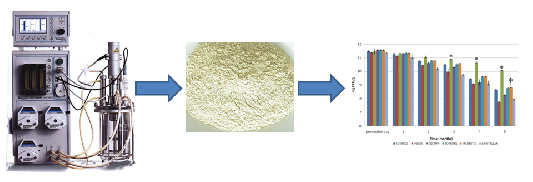Pilot-scale Production and Viability Analysis of Freeze-Dried Probiotic Bacteria Using Different Protective Agents
Abstract
:1. Introduction
2. Results and Discussion
2.1. Fermentations and Cell Yields
2.2. Viability of Freeze-Dried Strains during Storage


2.3. Evaluation of Molecular Stability during Storage

3. Experimental
3.1. Bacterial Strains
3.2. Pilot Scale Fermentation
3.3. Freeze-Drying
3.4. Viability during Storage
| Substances | Chemical nature | Prebiotic action |
|---|---|---|
| Inulin (In) | Oligosaccharide | yes |
| Dextrin (Dex) | Oligosaccharide | yes* |
| Crystalean® starch (Crys) | Resistant starch | yes* |
| Glycerine (Gly) | Polyalcohol | no |
| Sorbitol (Sor) | Polyalcohol | no |
| Mannitol (Man) | Polyalcohol | no |
3.5. Statistical Analysis
3.6. Molecular Stability during Storage
4. Conclusions
Acknowledgements
References and Notes
- Benno, Y.; He, F.; Hosoda, M.; Hashimoto, H.; Kojima, T.; Yamazaki, K.; Iino, H.; Mykkänen, H.; Salminen, S. Effects of Lactobacillus GG yogurt on human intestinal microecology in Japanese subjects. Nutr. Today 1996, 31, 9S–11S. [Google Scholar]
- Strategic Analysis of the European Food and Beverage Probiotics Markets; Frost & Sullivan: London, UK, 2007; pp. 1–40.
- Borruel, N.; Carol, M.; Casellas, F.; Antolín, M.; de Lara, F.; Espín, E.; Naval, J.; Guarner, F.; Malagelada, J.R. Increased mucosal TNFα production in Crohn’s disease can be downregulated ex vivo by probiotic bacteria. Gut 2002, 5, 659–664. [Google Scholar]
- Saxelin, M. Probiotic formulations and applications, the current probiotics market, and changes in the marketplace: a European perspective. Clin. Infect. Dis. 2008, 46, S76–S79. [Google Scholar] [CrossRef] [PubMed]
- Bottazzi, V.; Addeo, F.; Russo, G.L.; Iacomino, G. Probiotici & peptidi bioattivi; MOFIN ALCE: Novara, Italy, 2007; pp. 196–203. [Google Scholar]
- Hubálek, Z. Protectants used in the cryopreservation of microorganisms. Cryobiology 2003, 46, 205–229. [Google Scholar]
- Roberfroid, M. Prebiotics: the concept revisited. J. Nutr. 2007, 137, 830S–837S. [Google Scholar]
- Tuohy, K.M.; Rouzaud, G.C.M.; Bruck, W.M.; Gibson, G.R. Modulation of the Human Gut Microflora Towards Improved Health Using Prebiotics - Assessment of Efficacy. Curr. Pharm. Design 2005, 11, 75–90. [Google Scholar]
- Casiraghi, M.C.; Canzi, E.; Zanchi, R.; Donati, E.; Villa, L. Effects of a synbiotic milk product on human intestinal ecosystem. J. Appl. Microbiol. 2007, 103, 499–506. [Google Scholar]
- Cresci, A.; Orpianesi, C.; Silvi, S.; Verdenelli, M.C. Lactic acid bacteria strains exhibiting probiotic properties and compositions comprising the same. European Patent, 2007. [Google Scholar]
- Verdenelli, M.C.; Ghelfi, F.; Silvi, S.; Orpianesi, C.; Cecchini, C.; Cresci, A. Probiotic properties of Lactobacillus rhamnosus and Lactobacillus paracasei isolated from human faeces. Eur. J. Nutr. 2009, 48, 355–363. [Google Scholar] [CrossRef] [PubMed]
- Capela, P.; Hay, T.K.C.; Shah, N.P. Effect of cryoprotectants, prebiotics and microencapsulation on survival of probiotic organisms in yoghurt and freeze-dried yoghurt. Food Res. Int. 2006, 39, 203–211. [Google Scholar]
- Carvalho, A.S.; Silva, J.; Ho, P.; Teixeira, P.; Malcata, F.X.; Gibbs, P. Survival of freeze-dried Lactobacillus plantarum and Lactobacillus rhamnosus during storage in the presence of protectants. Biotechnol. Lett. 2002, 24, 1587–1591. [Google Scholar]
- Carvalho, A.S.; Silva, J.; Ho, P.; Teixeira, P.; Malcata, F.X.; Gibbs, P. Relevant factors for the preparation of freeze-dried lactic acid bacteria. Int. Dairy J. 2004, 14, 835–847. [Google Scholar]
- Saarela, M.; Virkajärvi, I.; Alakomi, H.L.; Mattila-Sandholm, T.; Vaari, A.; Suomalainen, T.; Mättö, J. Influence of fermentation time, cryoprotectant and neutralization of cell concentrate on freeze-drying survival, storage stability, and acid and bile exposure of Bifidobacterium animalis ssp. lactis cells produced without milk-based ingredients. J. Appl. Microbiol. 2005, 99, 1330–1339. [Google Scholar] [CrossRef] [PubMed]
- de Valdez, G.F.; de Giori, G.S.; de Ruiz Holgado, A.P.; Oliver, G. Comparative study of the efficiency of some additives in protecting lactic acid bacteria against freeze-drying. Cryobiology 1983, 20, 560–566. [Google Scholar]
© 2010 by the authors; licensee Molecular Diversity Preservation International, Basel, Switzerland. This article is an open-access article distributed under the terms and conditions of the Creative Commons Attribution license (http://creativecommons.org/licenses/by/3.0/).
Share and Cite
Savini, M.; Cecchini, C.; Verdenelli, M.C.; Silvi, S.; Orpianesi, C.; Cresci, A. Pilot-scale Production and Viability Analysis of Freeze-Dried Probiotic Bacteria Using Different Protective Agents. Nutrients 2010, 2, 330-339. https://doi.org/10.3390/nu2030330
Savini M, Cecchini C, Verdenelli MC, Silvi S, Orpianesi C, Cresci A. Pilot-scale Production and Viability Analysis of Freeze-Dried Probiotic Bacteria Using Different Protective Agents. Nutrients. 2010; 2(3):330-339. https://doi.org/10.3390/nu2030330
Chicago/Turabian StyleSavini, Michele, Cinzia Cecchini, Maria Cristina Verdenelli, Stefania Silvi, Carla Orpianesi, and Alberto Cresci. 2010. "Pilot-scale Production and Viability Analysis of Freeze-Dried Probiotic Bacteria Using Different Protective Agents" Nutrients 2, no. 3: 330-339. https://doi.org/10.3390/nu2030330





